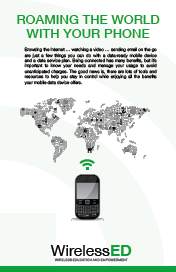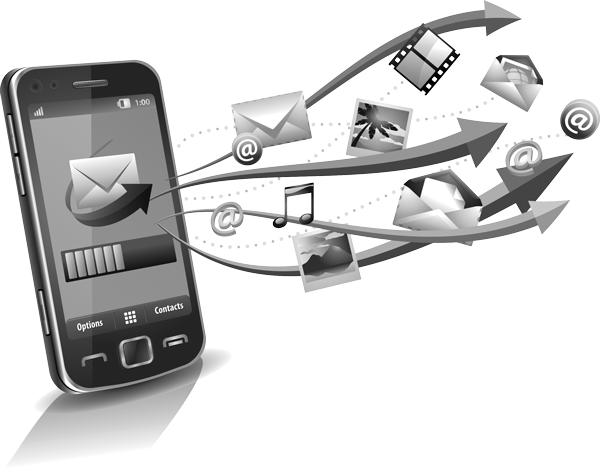Roaming the World with Your Phone
Being connected can make an international vacation more enjoyable, and an overseas business trip more productive. Planning ahead will enable travelers to save money on calls and messaging as well as keep their international data charges predictable.

Publication Series
- This publication is part of the WirelessED training module.
Download File
PDF files may contain outdated links.
Roaming the World with Your Phone
File Name: WirelessED_Internatinal_Roaming.pdf
File Size: 0.66MB
Languages Available
Table of Contents
Browsing the Internet … watching a video … sending email on the go are just a few things you can do with a data-ready mobile device and a data service plan. Being connected has many benefits, but it’s important to know your needs and manage your usage to avoid unanticipated charges. The good news is, there are lots of tools and resources to help you stay in control while enjoying all the benefits your mobile data device offers.
Roaming the world with your phone
Smartphone technology gives users the freedom to call family and friends, send and receive email and text messages, browse the Web, and even get some work done virtually anywhere in the world. Being connected can make an international vacation more enjoyable, and an overseas business trip more productive. Planning ahead will enable travelers to save money on calls and messaging as well as keep their international data charges predictable. This publication offers tips and tools to help you stay within budget while traveling with your data-ready device or phone.
What is international roaming?
You are roaming anytime you leave your wireless service provider’s coverage area. International roaming refers to using a network when traveling outside the United States, including travel in Mexico and Canada.
When you’re roaming, a new symbol, which varies from phone to phone, typically appears on your handset screen, usually in the area of the signal strength indicator. The name of the local carrier or network code also typically appears. Check your phone manual or contact your carrier to find out how your particular device indicates roaming.
Things to know before you go
Will your device work in the foreign country to which you are traveling?
Most of the world uses GSM technology, but many areas still use CDMA. If you have a CDMA phone, it will not work on a GSM network, and vice versa. Your phone also must work on the frequency (850/900/1800/1900) used by the country you’re visiting. Check your phone manual or contact your carrier to determine if your device is compatible.
Does your service provider offer international roaming service?
Most carriers must activate roaming capabilities before you leave the U.S. You should contact your carrier before leaving the U.S. to find out how to get the best rates on international roaming. Carriers typically provide discount roaming packages for voice, text and data. Typically, these plans give you a discounted per-minute rate for voice, or an allowance (bucket) for texts and data.
How many minutes or how much data will you need when traveling internationally?
When choosing an international roaming plan that offers buckets of minutes, text messages or data, it’s helpful to estimate your potential usage so you don’t have to pay higher rates for overage, or exceed your allotted number of minutes or data. The following tools and resources are available to help you estimate your usage and avoid incurring overage charges.
To determine how many minutes or how much bandwidth you might need when traveling internationally, estimate your usage in advance:
- Use an application ("app") provided by your carrier or a third party to track your usage.
- Reset your usage meter (under the general settings menu) and check it in a few days or a week to see your typical usage. Adjust this amount up or down if you expect to use significantly more or less service during your trip. (Note: Not all devices have a usage meter. Check your device manual or ask your carrier.)
- View the Using Mobile Data Wisely companion brochure for data usage estimates for common activities such as sending and receiving email, streaming music or downloading an application, game or song.
- Use the mobile data usage estimator at WirelessEd.org.
TIP: If you purchase a special plan for international travel, keep it for at least one full billing cycle to avoid being charged a fee for terminating the plan early.

Selecting an international roaming plan
While U.S. wireless users rarely encounter additional roaming costs when traveling domestically, voice and data service in other countries not included in your service plan. This means your bill will be higher if you use your phone outside the U.S. You can reduce the cost by purchasing an international roaming voice and/or data plan. These plans are available even for short periods of travel.
Some plans give you a discounted per-minute (voice) or per-byte (data) rate after you pay a relatively low flat monthly fee. For example, an international roaming voice plan might charge a flat fee (such as $5.99) and then discount the per-minute rate. Rates vary by country and can be a dollar or two per minute, even with the discount.
Another option may be to purchase a plan that allows you to use a specified amount of service (a bucket) for a flat price. Examples: 25 MB of data for $29.99, or 200 minutes of calling for $99, or 50 text messages for $10. Closely monitor your usage to avoid going over your allowances.
(On prepaid mobile or voice plans, international roaming may not be available, or may be available only in a very limited number of countries.)
It may take time for all the international charges to appear on your statement. Check with your carrier before cancelling your roaming plan to make sure you won’t be exposed to additional costs.
Tips while traveling
Monitor your usage when traveling - Start by resetting the usage tracker on your phone to zero (via the general settings menu) when you leave the U.S. Check it regularly to know how much service you’ve used. Service is typically broken down by voice, data, and SMS/text/multimedia messages.
Some carriers allow you to check your usage for free at any time on the carrier’s website, since you may not be able to check your usage from your handset while using international cell towers. Some carriers will also alert you when you approach your service limits for the month or when you are about to incur overage charges. However, there is typically some delay in receiving usage information from the roaming carriers, so it’s important to use available tools to monitor your own usage rather than rely on alerts provided by the carrier.
There are a variety of apps and online tools—offered by your carrier and third parties—for tracking usage. For example, an app like 3G Watchdog lets you set warning alerts before you exceed your allowance. Some tracking options (visiting the carrier’s site or using an application) may use data. Also, some tools may not be in real time. In other words, you may have used more service than is indicated.
For additional options for tracking your usage while traveling, view the Using Mobile Data Wisely companion brochure to get data usage estimates for common activities such as sending and receiving email, streaming music or downloading an application, game or song. You can also use the mobile data usage estimator at WirelessEd.org.
Minimize costs for data usage while roaming - Many automated functions and some applications use data even when you aren’t actively using your device. While traveling, take these steps to reduce or avoid costs for non-urgent data usage:
- Turn off your mobile network unless you need it. (Check your manual or contact your carrier if you need help with settings.)
- Set “fetch new data” and automated data-using functions to off or manual. You can temporarily activate them if you need to. (Auto functions include RSS news feeds, text message reminders and push notifications, for example.)
- Turn off applications (such as weather and Facebook) that check the Internet automatically.
- Set email on manual. This allows you to use data but prevents a large email file from downloading automatically.
- Set your phone to airplane mode. Turn it off if you need to make or receive a call. You should still be able to connect to Wi-Fi in airplane mode.
- Turn off functions or apps after you’ve finished using them.
- Use Wi-Fi instead of wireless carriers’ data services whenever possible. In some cases Wi-Fi may be free, but not always, and rates for Wi-Fi may vary around the world.
Checking voicemail from your handset while roaming will trigger international roaming rates. Be sure to factor this in when purchasing an international roaming package and tracking your usage.
TIP: Some popular travel apps such as iTranslate, Facebook, Google Maps and Yelp, can use a lot of data if accessed over wireless networks.
Roaming alternatives
If you choose not to take your mobile device with you when traveling abroad, you can explore other options for staying connected, such as renting a handset for the country you’ve visiting prior to leaving or purchasing a handset after you arrive.
If your phone is “unlocked”, you can buy a SIM card (a removable computer chip that holds your phone number and other subscriber information) with a local number in the country you are visiting. This option is available for unlocked tri-band or quad-band GSM phones. You can buy SIM cards from a variety of sources before you travel or you can purchase the card when you arrive at your destination. A new SIM card enables you to pay local rates for the calls you make within the country. However, with this option if you want to receive phone calls directly you will need to give out your new, foreign telephone number. Calls to your local U.S. number would go to voicemail. Check with your carrier about this option before you go.
You could also try Voice over Internet Protocol (VoIP) applications on your smartphone when it is set to Wi-Fi. For example, you can call other Skype users on their PCs in the U.S. and the call is free. To make an outbound call to a mobile or landline phone in the U.S. using Skype, you will be charged whatever the Skype calling rate is. However, VoIP applications such as Skype and Vonage may not always work for incoming calls from the U.S. to your mobile phone, as your mobile phone’s native dialer, not the VoIP application, may pick up the call and you could be charged roaming rates to accept the call. Check with your mobile device provider or the VoIP application provider before leaving the country to determine how VoIP calls to your device would be handled when you’re traveling internationally.
In this day and age of international travel it’s great to know there are many options available to stay connected with family, friends, and the office when out of the country. Roaming is complicated but with a little planning ahead, you can be prepared to use your wireless device almost anywhere!
Learn more and access tools to help measure your data usage at www.WirelessEd.org
Helpful resources
AT&T
General toll free number: 1-800-331-0500 or "611" from a wireless phone.
www.att.com/global
International Services: 1-800-335-4685
When calling from overseas: 1-916-843-4685
MetroPCS
Customer Support: 1-888-8metro8 (1-888-863-8768)
www.metropcs.com/products/TravelTalk/
Sprint
Sprint Worldwide Customer Support: 1-888-226-7212, option 2.
Information about travelling internationally with a Sprint phone:
shop.sprint.com/en/services/worldwide/travelabroad_sprint.shtml
T-Mobile
Customer Support: 1-877-453-1304
www.tmobile.com/International
Verizon
Customer Service: Dial *611 or call 1-800-922-0204 to enable International Roaming.
www.verizonwireless.com/global
US Cellular
Customer Support at 1-888-944-9400
www.uscellular.com/uscellular/common/common.jsp?path=/services/international/index.html
Find contact information for other carriers at www.WirelessEd.org.
Source – FCC, Tip Sheet: Wireless World Travel Made Simple
Published / Reviewed Date
Published: July 11, 2011
Download File
Roaming the World with Your Phone
File Name: WirelessED_Internatinal_Roaming.pdf
File Size: 0.66MB
Sponsors
AT&T
Filed Under
Copyright
© 2011 –2024 Consumer Action. Rights Reserved.



